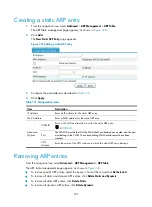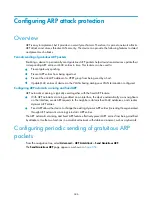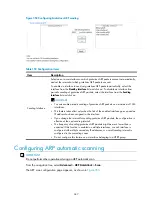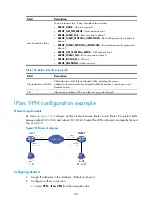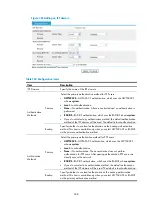
353
Item Description
Remote Gateway
Address/Hostname
Enter the address of the remote gateway, which can be an IP address or a host
name.
The IP address can be a host IP address or an IP address range. If the local end is the
initiator of IKE negotiation, it can have only one remote IP address and its remote IP
address must match the local IP address configured on its peer. If the local end is the
responder of IKE negotiation, it can have more than one remote IP address and one
of its remote IP addresses must match the local IP address configured on its peer.
The remote host name uniquely identifies the remote gateway in the network, and
can be resolved into an IP address by the DNS server. The local end can be the
initiator of IKE negotiation when the host name is specified.
Local Gateway Address
Enter the IP address of the local gateway.
By default, it is the primary IP address of the interface where the IPsec connection is
set up.
IMPORTANT:
Configure this item when you want to specify a special address (a loopback interface
address, for example) for the local gateway. The name or IP address of the remote
gateway is required for an initiator so that the initiator can find the remote peer in
negotiation.
Authentication Method
Select the authentication method to be used by the IKE negotiation. Options include:
•
Pre-Shared-Key
—Uses the pre-shared key method. If this option is selected, enter
the key in the
Key
field and enter the same key in the
Confirm Key
filed.
•
Certificate
—Uses the digital signature method. If this option is selected, select a
certificate from the list. Available certificates are configured in the certificate
management.
Remote ID Type
Select the remote ID type for IKE
negotiation phase 1. Options include:
•
IP Address
—Uses an IP address as
the ID in IKE negotiation.
•
FQDN
—Uses a Fully Qualified
Domain Name (FQDN) type of a
gateway name as the ID in IKE
negotiation. If this option is selected,
the remote gateway ID is required.
IMPORTANT:
•
If the IKE negotiation initiator uses the
FQDN or user FQDN ID type of the
security gateway as the ID for IKE
negotiation, it sends its gateway ID to
the peer, and the peer uses the
locally configured remote gateway ID
to authenticate the initiator. Make
sure that the remote gateway ID
configured here is identical to the
local gateway ID configured on its
peer.
•
In main mode, only the ID type of IP
address can be used in IKE
negotiation and SA establishment.
Local ID Type
Select the local ID type for IKE
negotiation phase 1. Options include:
•
IP Address
—Uses an IP address as
the ID in IKE negotiation.
•
FQDN
—Uses an FQDN type as the
ID in IKE negotiation. If this option is
selected, enter a name without any
at sign (@) for the local security
gateway, for example,
foo.bar.com
.
•
User FQDN
—Uses a user FQDN
type as the ID in IKE negotiation. If
this option is selected, enter a name
string with an at sign (@) for the local
security gateway, for example,
.
Selector
Select a method to identify the traffic to be protected by IPsec. Options include:
Summary of Contents for MSR SERIES
Page 17: ...xv Documents 835 Websites 835 Conventions 836 Index 838 ...
Page 20: ...3 Figure 3 Initial page of the Web interface ...
Page 42: ...25 Figure 13 Firefox Web browser setting ...
Page 59: ...42 Figure 27 Checking the basic service configuration ...
Page 73: ...56 Figure 35 Sample interface statistics ...
Page 156: ...139 Figure 139 Rebooting the 3G modem ...
Page 168: ...151 Figure 152 Configuring Web server 2 ...
Page 174: ...157 Figure 158 Configure the URL filtering function ...
Page 242: ...225 Figure 233 Enabling the DHCP client on interface Ethernet 0 1 ...
Page 247: ...230 Figure 236 The page for configuring an advanced IPv4 ACL ...
Page 255: ...238 Figure 241 Advanced limit setting ...
Page 298: ...281 e Click Apply 2 Configure Router B in the same way Router A is configured ...
Page 400: ...383 Figure 387 Verifying the configuration ...
Page 405: ...388 ...
Page 523: ...506 Figure 530 Ping configuration page ...
Page 775: ...758 Figure 785 Configuring a jump node ...

